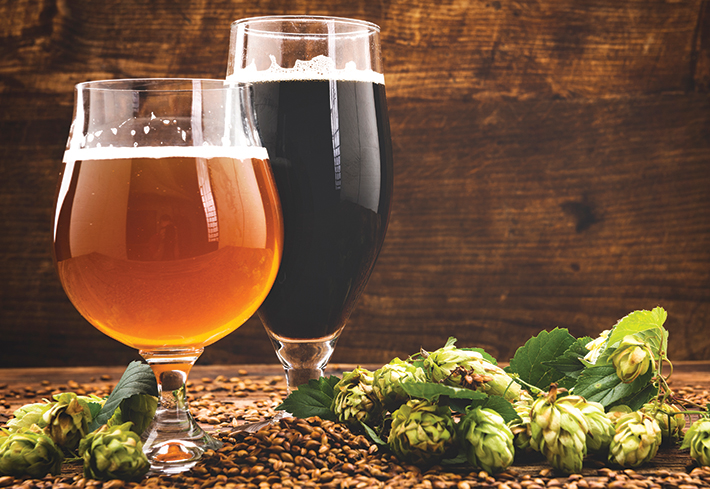
Standards and the Craft Beer Industry
For more than 30 years, New Belgium Brewing has been committed to values that prioritize people, communities, and the impact our work has on the environment. New Belgium was founded in 1991 in Fort Collins, Colorado, by Kim Jordan, a social worker who built her company people first. Carrying this ethos through the decades, our human-powered business model has laid the foundation for strong momentum and continuous growth. With operations across the country – including Asheville, North Carolina; Daleville, Virginia; and the acquisition of Bell’s Brewery in Comstock, Michigan – this people-centric model has led New Belgium to become one of the most popular and fastest-growing American craft brewers today.
Since its founding, New Belgium has maintained a comprehensive focus on product quality and innovation – critical components of producing world-class beer. The sensory department plays a significant role in quality-assurance efforts, relying heavily on ASTM International standards. With the help of ASTM’s Manual 14, The Role of Sensory Analysis in Quality Control, New Belgium has used sensory science for quality assurance, in which trained coworker-panelists learn to evaluate and describe beer in meaningful terms. Broadly, the serving protocol for sensory evaluation of foods and beverages (E1871) allows New Belgium to understand requirements for food-product testing. However, alcohol also presents unique challenges. Recognizing this, New Belgium has used and helped update the standard guide for evaluation of beverages containing alcohol (E1879) so that the industry can better serve alcoholic products safely and in a way that limits flavor carryover.
This sensory quality-assurance work is multifaceted. Our taste panel determines if changes in raw materials or processes impact the quality of beer through discrimination testing like the tetrad, triangle, and directional difference tests (standards E1855, E2164, and E3009, respectively). However, it’s not just the fresh beer that is considered. Shelf life of products is carefully monitored and set using methods drawn from the standard guide for sensory evaluation methods to determine sensory shelf life of consumer products (E2454), to confirm the beers maintain their high-quality taste throughout their full shelf-life.
New Belgium and its quality-assurance team prioritize the prevention of products with “off” or flawed flavors. In the past, analytical chemistry would set specification limits for analytically measurable off-flavors based on their experience and beer-science knowledge. However, implementing sensory threshold testing (E679) revolutionized how specification limits are set. With threshold testing, the sensory department works with New Belgium’s taste panel to determine the detectable amounts of off-flavors, allowing the analytical department to confidently set their specification limits below that threshold.
Aside from internal specifications and high thresholds for responsible marketing efforts, New Belgium is deeply committed to the advertising claims made.
The sensory department is also involved with innovation strategy and consumer insights. In the competitive world of beer and alcoholic beverages, any advantages gained by understanding consumers’ preferences, and using science to drive towards that goal, are well worth the effort. Manual 13, Descriptive Analysis Testing for Sensory Evaluation, helps staff understand the current product landscape and flavor profiles of prototypes in that space. The standard guide for structured small group product evaluations (E3093) is used to run effective small-group product evaluations with brand managers to increase learning and streamline the innovation process. Once products are ready for testing, the standard guide for two-sample acceptance and preference testing with consumers (E2943) ensures recommended procedures for consumer testing are followed.
Sensory science relies on humans as its measuring tool. This is a challenge, as every panelist is unique, yet they need to function as one panel. Selecting and training panelists (STP 758) is therefore of the utmost importance, and providing panelists feedback on their performance broadly (E3313) and on specific test methods like descriptive analysis (E3000) helps the sensory department correct and align panelists to produce the best sensory data possible, and in turn, supply the best beer possible.
Prioritizing time and effort on not only internal protocols, but also on updating E1879 has been an ongoing effort. Though the demands of the craft-beer industry are significant and ever-changing, New Belgium believes that helping to develop ASTM standards is undoubtedly worth time and effort. By using industry-approved standards, we know the methods used are best-in-class and can improve the industry as a whole.
The committee on sensory evaluation (E18) has been a huge source of knowledge, both tangible and intangible. Through ASTM, standards like E1985 and E3093 have come into use. By implementing them, New Belgium has been able to be more effective as a sensory department and gain an even greater competitive advantage. Staff who are members of ASTM develop standards side-by-side with the giants of the sensory-science community. ASTM has expanded knowledge in intangible ways, from a better understanding of the statistics involved in the testing performed to the ways sensory is performed on other products. Overall, ASTM has allowed the sensory department to help create new brands, test them with consumers, and ensure the quality of the beer is world class. ■
 SN Home
SN Home Archive
Archive Advertisers
Advertisers Masthead
Masthead RateCard
RateCard Subscribe
Subscribe Email Editor
Email Editor